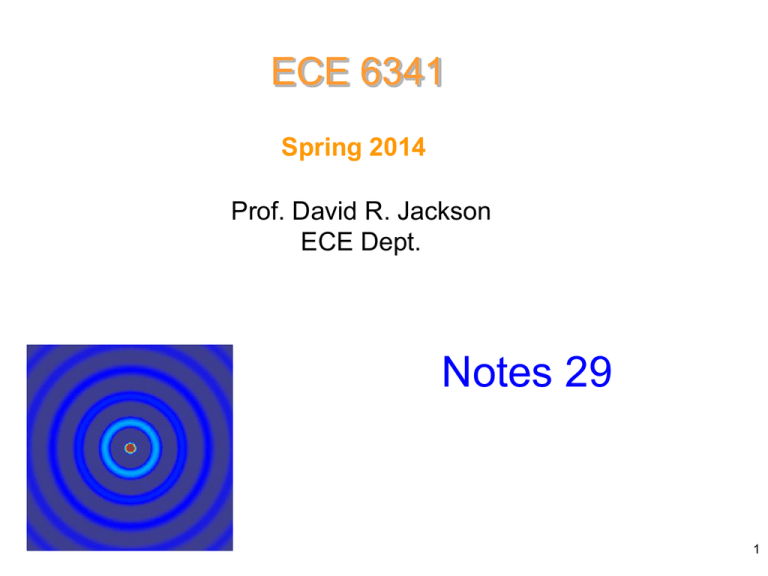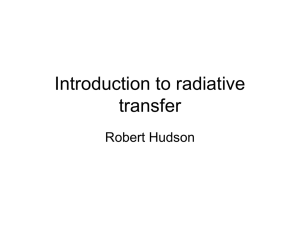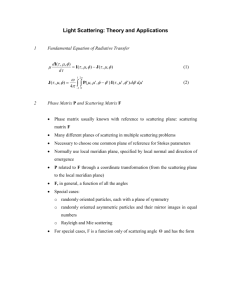6341 notes 29 High Frequency Scattering by Cylinder
advertisement

ECE 6341 Spring 2014 Prof. David R. Jackson ECE Dept. Notes 29 1 High-Frequency Scattering by Cylinder y E i a ka 1 x PEC cylinder H i E zˆ e jkx i 1 jkx ˆ H y e i Assume 2 Physical Optics Physical Optics Approximation E i H i Lit Normal Dark Dark region (not seen by incident plane wave) J s 0 on dark region 3 Physical Optics (cont.) Physical Optics Approximation Lit Dark Locally, the reflection acts like plane-wave reflection from a flat surface. 1 (PEC) Normal J s nˆ H Lit region: nˆ H 2 nˆ H ˆn H nˆ H i H r nˆ H i i i 4 Physical Optics (cont.) Physical Optics Approximation E i H i Lit Lit region: Dark region: Dark i ˆ J s 2n H Js 0 5 High-Frequency Scattering by Cylinder (cont.) Physical Optics Approximation 2 nˆ H i , Lit region Js 0, Dark region Lit region: 2 3 2 y a PEC x lit 6 High-Frequency Scattering by Cylinder (cont.) 1 jkx J s 2 ˆ H 2 xˆ cos yˆ sin yˆ e i 2 zˆ cos e jkx 2 J s zˆ cos e jka cos or 2 3 2 7 High-Frequency Scattering by Cylinder (cont.) Scattered field: Consider a z-directed line source at the origin: y I x Az I 4j H 0(2) k 2 2 (2) Ez k A j A I H z z 0 k j z 4 1 8 High-Frequency Scattering by Cylinder (cont.) Far field: 2 jk Ez ~ I e e 4 k Next, For consider current atthe line source to be located at (x´, y´): j 4 , include phase shift terms j k xk = phase term e k x k cos k y k sin Hence e x y y x a cos y a sin jka cos 9 High-Frequency Scattering by Cylinder (cont.) 2 or jk 4 Ez ~ I e e 4 k j Hence, letting e jka cos I dI J sz ad Hence dEzs dI 4 2 jk j 4 jka cos ' e e e k or or j 2 s jk 4 jka cos dEz e e e J sz a d 4 k 10 High-Frequency Scattering by Cylinder (cont.) or j 2 2 jka cos jk 4 jka cos dEzs cos e ad e e e 4 k Hence Integrating, 3 /2 j 2 j ka cos cos s jk 4 Ez e e a cos e d /2 2 k For the integral 11 High-Frequency Scattering by Cylinder (cont.) This may be written as 2 jk 4 E e e aI 2 k j s z where Hence I 3 /2 /2 cos e j ka cos cos d I f x e jg x dx b Compare with a For the integral Hence, we can identify f cos g cos cos ka 12 High-Frequency Scattering by Cylinder (cont.) Find the stationary-phase point (SPP): SPP g cos cos sin sin 0 sin sin g 0 0 or 0 0 0 A 0 0 2 n 2 n g 0 (No SPP. Assume 2 n) 0 sin A sin B A B 2 n or A B 2 n B 0 0 2 n 0 n 2 2 13 High-Frequency Scattering by Cylinder (cont.) We require the (b)restriction that 3 0 , 2 2 From the previous slide, 0 n since 2 2 Also, 0 2 choose Hence, choose n = -1 : 0 2 2 14 Geometrical Optics The specular point of reflection is the point at which the ray reflects Specular point off and travels to the observation point. Observation point We can show that Specular point y s s 0 x 15 Geometrical Optics (cont.) Specular point Proof s 0 2 2 s 2s y s s 2 2 x 16 High-Frequency Scattering by Cylinder (cont.) Note that there is always a stationary-phase point, for all Then observation angles (except = 0). y 0 2 2 x 17 High-Frequency Scattering by Cylinder (cont.) Next, calculate the g function at the stationary-phase point: At SPP: g cos cos g 0 cos 0 cos 0 cos cos 2 2 2 2 cos cos 2 2 2 2 sin sin 2sin 2 2 2 18 High-Frequency Scattering by Cylinder (cont.) Next, calculate the second derivative of the g function: At SPP: g cos cos g 0 cos 0 cos 0 g 0 2sin 2 Note: g 0 0 19 High-Frequency Scattering by Cylinder (cont.) Recall: jg x Hence theI integral f ( x )ise 0 0 , g x0 0 j 2 e 4 g x0 , g x0 0 f cos 0 g cos cos g 0 2sin 2 g 0 2sin 2 2 ka 2 Hence j 2 j ka 2sin 2 I ~ cos e e 4 2 2 ka 2sin 2 20 High-Frequency Scattering by Cylinder (cont.) I ~ cos e 2 2 Use or j ka 2sin 2 2 ka 2sin e j 4 2 cos sin 2 2 2 Then we have I ~ sin e ka 2 j ka 2sin j 2 4 e 21 High-Frequency Scattering by Cylinder (cont.) Recall j 2 Ezs e jk e 4 a I 2 k Then Therefore j ka 2sin j 2 2 Ezs ~ e jk e 4 a e 4 sin e 2 k 2 ka j or / k or a jk E ~ sin e e 2 2 s z j ka 2sin 2 22 High-Frequency Scattering by Cylinder (cont.) Then a jk E ~ sin e e 2 2 s z j ka 2sin 2 Radiation pattern of cylinder (scattered field) y y E i a ka 1 x x PEC cylinder H i 23 High-Frequency Scattering by Cylinder (cont.) In the backscattered direction ( = ): Then a jk j 2 ka E ~ e e 2 s z Echo width (monostatic RCS): E0 We 2 2 s 2 z 1 E 2 2 We lim Note: E0 = 1 in our case. 2 E E0 s 2 z 2 24 High-Frequency Scattering by Cylinder (cont.) We 2 E Then s 2 z a jk j 2 ka E ~ e e 2 s z Hence a We 2 2 We a 2 a (circumference of lit region) 25

